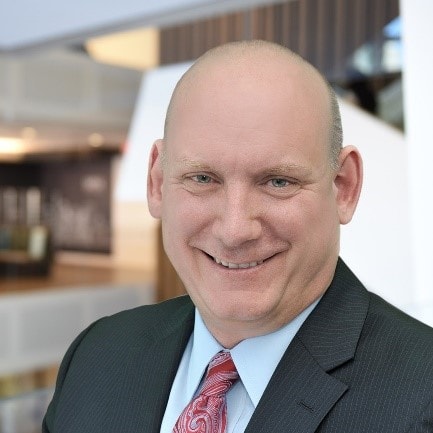
Delivering digital talent Preparing the logistics and distribution workforce for Industry 4.0 and the connected supply network
09 July 2018
Much has been made of how Industry 4.0 has transformed logistics and distribution. But what happens when talent is brought into the picture? Organizations will not only need to consider new skillsets, but transform recruiting, management, and retention strategies.
At FedEx’s large distribution center in the Piedmont region of North Carolina, Jefe has joined the team. Jefe is not a person, but a robot, and is among a growing group of robots at the FedEx facility that transports packages throughout the massive complex—from the point of arrival to another spot for further sorting. As it pulls a “tugger” to transport the packages, each of the FedEx robots has sensors and navigation to guide its journey—avoiding workers and objects along the way. Some robots even have the cognitive tools to optimize future journeys based on prior experience. What is happening at the FedEx facility in North Carolina—and distribution facilities like it globally—is a growing trend toward process automation in the logistics and distribution (L&D) industry, machines taking on the tasks that humans previously carried out. However, as this trend continues seemingly unabated, the question remains: How will this trend toward automation recast the role of the human worker?1
Introduction
The digital economy has changed virtually everything about how people buy goods—from the infrastructure of commerce to systems of payment, to the psychology of consumer preference and expectations. But what has not changed is the enduring fact that it is still physical goods that people buy. For the digital economy to function properly, physical goods still need to be moved from place to place and be warehoused. Put simply, today’s digital world seems to be only increasing the need for physical logistics.2
Learn More
Explore the Industry 4.0 collection
Subscribe to receive updates on Industry 4.0
Listen to Following the digital thread, a podcast from Deloitte Insights
Even though the demand for L&D continues steadily, the sector is experiencing some challenges: shortage of skilled labor, high employee turnover, and an aging workforce, among others.3 These challenges seem further exacerbated by the advent and incorporation of new technologies that are reshaping the sector.
These disruptive technologies, which are part of the fourth industrial revolution known as Industry 4.0,4 are leading to shifts in demand for skills and even refining traditional job functions, as organizations are asking new and different things of their workforce. Indeed, Industry 4.0-driven technologies—and the emerging digital supply network (DSN) that these technologies make possible—are already resulting in the evolution of human practices within L&D, leading to shifting roles and the emergence of new jobs. Further, these technology shifts tend to present the challenge of managing both humans and machines, often resulting in a need to introduce alternative talent models and update current talent management strategies.
Many L&D organizations are cognizant of these changes, and the challenges they can portend. In a recent survey, 63 percent of the respondents indicated hiring and retaining the correct skilled workforce as the biggest barrier in their respective organization’s transformation.5 The ability to acquire future skills and evolve the current L&D talent pool can mean the difference between a successful digital transformation and one that may not adequately adapt to changing competitive demands.
The ability to acquire future skills and evolve the current L&D talent pool can mean the difference between a successful digital transformation and one that may not adequately adapt to changing competitive demands.
In an earlier paper, Industry 4.0 and distribution centers, we took an in-depth look at how the disruptive technologies of Industry 4.0 could affect the L&D organization, generally, in driving greater flexibility and productivity. In this paper, we will focus on the disruptive effect of Industry 4.0 technologies on L&D talent. We will examine the potential changes in skill requirements and operational structure brought about by these technologies, and explore some strategies to recruit, retain, manage, and develop talent to help prepare L&D organizations for the technological transformation.
What is Industry 4.0?
The concept of Industry 4.0 incorporates and extends digital connectivity within the context of the physical world in digital enterprises and DSNs. This drives the physical act of manufacturing, distribution, and performance in an ongoing cycle known as the physical-to-digital-to-physical (PDP) loop (figure 1).
The Industry 4.0 technologies combine digital information from many different physical and digital sources and locations, including the Internet of Things and analytics, additive manufacturing, robotics, high-performance computing, artificial intelligence and cognitive technologies, advanced materials, and augmented reality.
Throughout this cycle, real-time access to data and intelligence is driven by the continuous and cyclical flow of information and actions between the physical and digital worlds. Many manufacturing and supply chain organizations already have some portions of the PDP loop in place, namely, the physical-to-digital, and digital-to-digital processes. However, it is the leap from digital back to physical—from connected, digital technologies to action in the physical world—that constitutes the essence of Industry 4.0.6

As these technologies are deployed in factories7 and throughout the supply networks, 8 we have seen how Industry 4.0 has reshaped not just which products manufacturers make, but also how they make and, ultimately, deliver them. It has also changed the relationships customers and suppliers have with these manufacturers to something more continuous and open-ended.9 In many downstream uses of Industry 4.0, technologies can fundamentally change how companies connect with their clients, through deeper customer relationships and enhanced efficiency.
For further information, read Forces of change: Industry 4.0 and Industry 4.0 and manufacturing ecosystems: Exploring the world of connected enterprises.
The effects of digital transformation on L&D talent
Industry 4.0 could have a profound effect on the industrial workforce. This can result in anxiety for leaders; a recent Deloitte survey found that just 25 percent of executives felt highly confident that they possess the right workforce composition and skillsets needed for the future.10 This anxiety is likely also high within an L&D organization.
The L&D organization is a critical component of the DSN, the fully integrated, open system of supply operations made possible by Industry 4.0-driven technologies. To learn more about the DSN and the ways it leverages Industry 4.0 technologies, please see The rise of the digital supply network.
Consider just some of the shifts that are already taking place: Orders can come in and be processed at any time, while inventory, too, can be in constant motion. The real-time tracking of trucks on the road and planes in the air means that continuous planning can optimize routes during the day to minimize empty legs and lost revenue. Even the role of picking goods to be packaged together has changed dramatically: Paper lists have been replaced by voice picking in many warehouses, and a further shift to augmented reality (AR) is already underway.11 In other warehouses, robots bring the right shelf to the pickers, who remain stationary.12 In fact, automation may take on the whole of picking tasks; researchers at MIT have introduced a drone-based wireless system that can scan and locate items in warehouses faster than any human.13
These are just a few examples of the ways in which roles could change. The transition can span the full range of the L&D value chain. Indeed, L&D professionals would require new skillsets to manage and operate alongside emerging technologies. We explore these skillsets below.
Knowledge of technology
At the most basic level, new technology in the workplace typically forces workers to learn the skills necessary to work with that new technology.14 For example, in the logistics domain, workers using wearable AR to pick goods would not only need to know how to accept and clear new tasks, but also how those changes will interact with warehouse spaces and the back-end technology. Some technologies might also require new back-end skillsets within organizations to maintain servers, program applications, troubleshoot any technological issues, and repair machines. Individuals in managerial roles would also need to understand the intricacies of the role and technologies, and be able to manage and evaluate their staff members using data-driven performance tools.
Knowledge across the value chain
As technologies redefine tasks, many traditional tasks are being combined. For example, previously “siloed” activities such as logistics planning, coordination, and freight payment might be executed by one role or individual in the future, with the help of blockchain and the Internet of Things (IoT).15 To execute this as an integrated process, traditionally segregated L&D roles, such as logistics coordinators and billing specialists, might be consolidated—requiring individuals in the new roles to have knowledge of additional supply chain and non-supply chain processes.16 In this way, individual workers would need knowledge of the organization spanning the entire value chain.
Change management skills
Enacting change is perhaps one of the most challenging initiatives any organization can undertake. The change brought about by new technologies, especially, is often doomed to fail if workers refuse to use them. Failure rates of 60–70 percent can be found in organizational change projects that do not employ a formal change management process that helps workers understand the strategic aim of new technologies within a personal context. 17 A successful change management process is largely dependent on a receptive and agile talent pool. Indeed, research has shown that technologies are more likely to be accepted and used by workers if they see the value in their work and are provided with the right support to enable their personal successful transition.18 Accordingly, organizations should cultivate leaders, project teams, and individuals with strong change management acumen in order to develop and communicate the transition strategy to employees and potentially union stakeholders, an important group within L&D.
Failure rates of 60-70 percent can be found in organizational change projects that do not employ a formal change management process that helps workers understand the strategic aim of new technologies within a personal context.
The introduction of a new technology in an industrial environment can cause changes in how industrial workers need to operate. They should learn the technologies that affect them, of course; however, they will also generally need to understand how potentially disruptive technologies affect the entire organization. The onus is just as much on the leaders of the organization to ensure that workers do not lose perspective of how their individual roles may evolve—and perhaps become more relevant and value-added—in an increasingly digital environment.
Making the L&D organization “talent-ready” for digital transformation
Emerging technologies can require L&D organizations to be proactive and agile in preparing their employees for the future of Industry 4.0 and the DSN. This often involves not only developing internal capability and capacity, but also looking outside the organization for partnerships, collaborations, and talent—and rethinking the ways in which they hire, train, and retain workers. It may also call for a “rethinking” of how organizations incentivize employees. Below, we explore some steps for adapting a talent organization.19
Figure 2 shows how automation, talent, and location are three factors that may push work in a new direction. Specifically, we recognize that the “what” (automation/augmentation), “who” (workforce), and “where” (workplaces, location) of work are dramatically changing. Figure 2 illustrates that the journey that companies may choose to make in responding to these changes can be one from a highly concentrated, lower automation, narrower talent model to one that is increasingly more heterogeneous and automated. In this emerging model, proximity is no longer the defining advantage as the internet has made proximity less important, and now people (and robots) can work from virtually anywhere. In this new model, roles and who can fill them are being reimagined in ways that defy long-standing orthodoxy.
Accordingly, the analysis that follows will occur through the prism of three sets of fundamental strategic questions (see figure 2):
- The “what”: What work can be automated or augmented in an age of digital transformation?
- The “who”: Who can do the work? How is the workforce changing within L&D?
- The “where”: Where is the work done? How do you redesign the workplace experience within L&D?

Work: The “what”
Connected, autonomous technologies can profoundly affect and augment the work that takes place within an L&D organization. But what does that mean in a specific sense? Here, we take a deeper look at some specific technologies and the ways in which they may shift how work is done within the L&D environment.
- Sensing systems: Warehouse operations, in-transit tracking, fleet management
Sensing systems—including wearable devices—play a foundational role in the successful implementation of Industry 4.0 solutions. The information they provide helps link the physical and digital worlds, driving Industry 4.0 and, by extension, the DSN. In just one case example, a small startup enhances pallets with radio-frequency-based sensing devices to allow organizations to better track their cargo.20 Within a warehouse, automated-guided vehicles (AGVs) equipped with laser sensors are but another example.21 For their part, wearable devices such as smart glasses and other head-mounted wearables have realized a number of L&D-related applications, including the use of AR for maintaining and repairing vehicles and machinery.22 In another example, one major logistics company is using AR-based wearables to optimize the travel time in fulfilling picking lists.23
- Cognitive technologies: Warehouse management, logistics control, in-transit tracking, fleet management
Cognitive technologies can “perform and/or augment tasks, help better inform decisions, and accomplish objectives that have traditionally required human intelligence, such as planning, reasoning from partial or uncertain information, and learning.”24 These technologies can be useful in replacing many L&D tasks that require a measure of human judgment, reasoning, and physical exertion, as well as some repetitive tasks. 25 For example, linking cognitive-based predictive maintenance processes in a manufacturing environment to logistics or parts-ordering systems can enable automatic reordering of parts as needed, leading to more efficient inbound logistics.26
- Driverless vehicles and drones: Delivery, in-transit tracking, fleet management
Autonomous mobility has noteworthy applications throughout the L&D setting. For example, RFly, a drone-based wireless system developed recently by engineers at MIT, uses reflected radio waves to locate and identify packages in large warehouses faster than humans.27 For its part, a major package delivery company sees great potential in delivering packages over short distances by way of drone technologies, estimating savings up to $50 million annually.28 Further research in this regard suggests other promising developments.29
Workforce: The “who”
These and other technology domains will likely have a substantial effect on the traditional roles within the L&D organization. As roles evolve, new opportunities may emerge.
For example, the increasing use of cognitive technologies within the L&D environment can free workers from some repetitive and routine tasks, enabling them to focus on more value-added duties that are uniquely human and otherwise not candidates for automation, such as negotiation and team management.30 This can result in noteworthy benefits for an organization: Moving workers to such value-added tasks would not only help workers see technology as a help rather than competition for their jobs, but could also increase productivity. At the same time, however, this increasing emphasis on cognitive technologies may drive the need for retraining in such related areas as programming, maintenance and configuration, as workers must learn how to use and maintain new tools.31
But the story doesn’t end with how the L&D workforce can accept and adapt to the assimilation of new technologies. It also can require organization-wide commitments through such initiatives as:
- Creating technical experts: As new digital technologies transform the L&D environment, it is also important to ensure that relevant experts emerge and are recognized within the company to own areas such as configuration and maintenance requirements of the newly installed digital technologies—particularly as the pace of change accelerates. This can be accomplished in part through developing in-house expertise, or leveraging a strong support desk from externally sourced technology solution providers. However it is developed, whether internally or by way of outsourcing, the organization’s offering of expertise should come to represent the full spectrum of “tech fluency” over time.32
- Exploring the alternative workforce: As the talent needs of a company might shift rapidly with new digital technology, organizations may need to look toward other arrangements with talent beyond conventional full-time employment. Many L&D companies have already discovered this, with nearly 82 percent using supplementary, temporary, or contract workers.33 In addition to traditional on-balance sheet workforce, companies can harness talent from partners, consultants or contractors, freelancers, and open-source talent to find the right mix of skills and nimbly respond to emerging technology and logistics needs.
- Looking for new types of talent: The skills required to operate and manage much of the emerging and potentially disruptive technology inherent in Industry 4.0 often means that L&D companies are competing for some of the same talent as the tech giants. To compete with large Silicon Valley companies in attracting talent, an L&D organization may need to look above and beyond its usual talent pipelines. At one of the world’s largest internet retailers, for example, the new logistics staff mainly comprises operational researchers and mathematicians.34 Further, in staffing its logistics team, a San Francisco-based freight forwarder believes in hiring an “intelligent workforce” with analytical thinking and creative problem skills—before considering any logistics-specific experience.35 The pursuit of “out of the box” talent may invite the use of data analytics in talent assessment and workforce planning. Indeed, many organizations recognize the value of talent analytics to help derive a more accurate picture of the areas that require development.36 But it can be challenging to gain deeper understanding of one’s own talent pool. Leveraging talent analytics to identify areas where the work could be better performed by a non-balance-sheet workforce, or perform cost-benefit analyses to assess the feasibility of alternative talent models—such as the placement of liberal arts graduates in traditional STEM roles—may prove fruitful.37
The skills required to operate and manage much of the emerging and potentially disruptive technology inherent in Industry 4.0 often means that L&D companies are competing for some of the same talent as the tech giants. To compete with large Silicon Valley companies in attracting talent, an L&D organization may need to look above and beyond its usual talent pipelines.
Workplace: The “where”
No analysis of the emerging L&D talent model in the wake of digital transformation can be complete without due consideration of the environment within which that work takes place. However profoundly digital transformation may affect L&D work and workforce roles, an examination of the organizational ethos in a post-digital world can be just as important. What follows are several points for consideration in that regard:
- Elevate the importance of career experiences: The traditional approaches to luring top talent may no longer be enough. While searching for jobs, today’s younger workforce especially often looks beyond just monetary compensation, seeking out career-building experiences as well. Deloitte’s 2018 Global Human Capital Trends report highlights the important role that career experiences play in shaping a long-term committed workforce and attracting key talent. Unfortunately, only 9 percent of respondents said that their organizations are “very ready” in addressing this challenge.38 This underscores the urgency that L&D employers should place in reassessing their employee experience map to ensure employees are constantly engaged and satisfied throughout their career.
- Tailor reward mechanisms to fit personal needs: The “one size fits all” approach to career compensation and rewards—along with other aspects of the talent paradigm—should be reconsidered and rewired for workers to achieve more customized outcomes. Toward that end, the 2018 Global Human Capital Trends report illustrates several case examples that show how more individualized reward systems can meaningfully enhance worker engagement and bottom-line results. 39 Moreover, with the introduction of analytical and technical roles within L&D organizations, leaders should consider examining compensation and reward structures of comparable analytical and technological firms to make these newly added L&D roles competitive for top talent.
- Promote a culture of learning: As Deloitte’s 2018 Global Human Capital Trends report points out, the 21st century organization requires a reconfiguration of what learning means to the individual worker.40 This is especially true as the adoption of new technologies reshapes roles and demands that workers learn new skills.41 Technologies such as augmented and virtual reality also present learning opportunities as they can enhance training effectiveness. Indeed, upgrading internal talent—equipping the workforce with the knowledge and skills to adopt, keep up with, or stay in front of the emerging technologies—could be more vital than ever. Establishing and implementing effective training priorities as part of an overarching culture of learning would therefore be very important. Given the rapidity of change, learning may also need to be ongoing, potentially requiring employees to own and initiate the learning process themselves. To some extent, this could require employees to pursue reimbursable outside classes to update and refresh skills.42
- Seek external collaborations: In developing a culture of learning, organizations may not have the capacity or the capability to establish their own training systems or manage complex change management strategies. Partnerships with external organizations—whether universities, technical schools, or even companies in other industries—can enable quick access to the needed expertise.43 For L&D organizations, specifically, education and certification providers such as APICS, the association for supply chain management, can be a relevant step.44
Final thoughts
Technology-driven change in almost any organization appears inevitable. It is also seldom easy. In one way or another, emerging technologies can often affect every function and the talent that carries out these functions within the organization, every day. This phenomenon is particularly applicable within the L&D function, where established processes and “ways of doing things” may be deeply entrenched.
L&D organizations should never lose sight of the basic premise that any adoption of emerging technology is only as successful as talent allows it to be. As such, L&D organizations should keep in mind three overarching principals as they undertake a new technology initiative:
- Talent requirements should remain a pillar of any strategy for new technology implementation in an L&D organization, and not a postscript.
- Technology implementation can affect different aspects of the L&D talent group differently—from warehouse and logistics operators to managerial and executive roles. An organization can work to understand how new technology varies in its impact, and provide the appropriate motivation and support accordingly. In so doing, organizations may be well advised to keep the workforce “in the loop”—a key part of the technology implementation thinking.45
- Change management, well-thought out training and retention programs, and other support mechanisms can help ensure that Industry 4.0-driven strategies are sustainable. Toward this end, a close partnership between L&D and HR leadership can be critical to success.46
At the end of the day, in order to meet the future requirements of physical logistics and maintain profitability, embracing technology disruption is important to the success of an L&D organization and to a business overall. Keeping talent at the forefront of this endeavor can safeguard a successful transition to this emerging strategic vision and help an L&D organization fulfill its important mission within the larger digital supply network.
© 2021. See Terms of Use for more information.










